Podcast
Questions and Answers
What is the first step in adding two fractions?
What is the first step in adding two fractions?
- Combine the numerators and denominators.
- Find the least common multiple of the numerators.
- Convert each fraction to a mixed number.
- Identify the type of fractions. (correct)
What should you do when adding like fractions?
What should you do when adding like fractions?
- Add the numerators and keep the denominator the same. (correct)
- Convert them to mixed numbers before adding.
- Add the denominators and keep the numerators the same.
- Find a common denominator before adding.
When adding the fractions $\frac{1}{4}$ and $\frac{1}{6}$, what is the least common multiple of the denominators?
When adding the fractions $\frac{1}{4}$ and $\frac{1}{6}$, what is the least common multiple of the denominators?
- 10
- 8
- 24
- 12 (correct)
After converting $\frac{1}{4}$ to a common denominator of 12, what is the equivalent fraction?
After converting $\frac{1}{4}$ to a common denominator of 12, what is the equivalent fraction?
What is the result of adding $\frac{3}{8}$ and $\frac{1}{4}$?
What is the result of adding $\frac{3}{8}$ and $\frac{1}{4}$?
What is the final step after adding fractions and before writing the answer?
What is the final step after adding fractions and before writing the answer?
If you have a mixed number, what is the first step to add it with another fraction?
If you have a mixed number, what is the first step to add it with another fraction?
What is the result of $\frac{2}{3} + \frac{1}{6}$ after following proper addition steps?
What is the result of $\frac{2}{3} + \frac{1}{6}$ after following proper addition steps?
Flashcards are hidden until you start studying
Study Notes
Understanding Adding Two Fractions
-
Definition: Adding fractions involves combining two or more fractions into a single fraction.
-
Types of Fractions:
- Like Fractions: Fractions with the same denominator.
- Unlike Fractions: Fractions with different denominators.
Steps to Add Fractions
-
Identify the Type of Fractions:
- Check if the fractions have like or unlike denominators.
-
For Like Fractions:
- Keep the denominator the same.
- Add the numerators.
- Example:
- ( \frac{2}{5} + \frac{3}{5} = \frac{2 + 3}{5} = \frac{5}{5} = 1 )
-
For Unlike Fractions:
- Find a common denominator.
- The least common multiple (LCM) of the denominators is often used.
- Convert each fraction to an equivalent fraction with the common denominator.
- Add the converted fractions.
- Example:
- ( \frac{1}{4} + \frac{1}{6} )
- LCM of 4 and 6 is 12.
- Convert: ( \frac{1}{4} = \frac{3}{12} ) and ( \frac{1}{6} = \frac{2}{12} )
- Add: ( \frac{3}{12} + \frac{2}{12} = \frac{5}{12} )
- ( \frac{1}{4} + \frac{1}{6} )
- Find a common denominator.
-
Simplification:
- If possible, simplify the resultant fraction by dividing the numerator and the denominator by their greatest common divisor (GCD).
Key Points
- Common Denominator: Essential for adding unlike fractions.
- Simplification: Always check if the final answer can be simplified.
- Mixed Numbers: If adding mixed numbers, convert them to improper fractions first, then follow the steps above.
Practice Examples
- ( \frac{1}{2} + \frac{1}{2} = 1 )
- ( \frac{3}{8} + \frac{1}{4} )
- Convert ( \frac{1}{4} ) to ( \frac{2}{8} )
- Result: ( \frac{3}{8} + \frac{2}{8} = \frac{5}{8} )
- ( \frac{2}{3} + \frac{1}{6} )
- Convert ( \frac{2}{3} ) to ( \frac{4}{6} )
- Result: ( \frac{4}{6} + \frac{1}{6} = \frac{5}{6} )
Conclusion
- Mastery of adding fractions requires practice with identifying fractions, finding common denominators, and simplifying results.
Understanding Adding Two Fractions
- Adding fractions combines two or more fractions into one total.
- Like Fractions: Fractions that share the same denominator.
- Unlike Fractions: Fractions with different denominators.
Steps to Add Fractions
- Identify Fraction Types:
- Determine if fractions are like or unlike prior to addition.
- For Like Fractions:
- Retain the denominator.
- Sum the numerators directly.
- Example: ( \frac{2}{5} + \frac{3}{5} = \frac{5}{5} = 1 ).
- For Unlike Fractions:
- Identify the least common multiple (LCM) of the denominators for a common denominator.
- Convert each fraction to an equivalent fraction using this common denominator.
- Add the resulting fractions.
- Example:
- For ( \frac{1}{4} + \frac{1}{6} ), the LCM of 4 and 6 is 12.
- Convert ( \frac{1}{4} ) to ( \frac{3}{12} ) and ( \frac{1}{6} ) to ( \frac{2}{12} ).
- Add: ( \frac{3}{12} + \frac{2}{12} = \frac{5}{12} ).
- Simplification:
- Always simplify the resultant fraction if possible by using the greatest common divisor (GCD).
Key Points
- Common Denominator Importance: Necessary for properly adding unlike fractions.
- Simplification Check: The final answer should be examined for potential simplification.
- Mixed Numbers Handling: Convert mixed numbers to improper fractions before following addition steps.
Practice Examples
- ( \frac{1}{2} + \frac{1}{2} = 1 ).
- For ( \frac{3}{8} + \frac{1}{4} ):
- Convert ( \frac{1}{4} ) to ( \frac{2}{8} ).
- Result: ( \frac{3}{8} + \frac{2}{8} = \frac{5}{8} ).
- For ( \frac{2}{3} + \frac{1}{6} ):
- Convert ( \frac{2}{3} ) to ( \frac{4}{6} ).
- Result: ( \frac{4}{6} + \frac{1}{6} = \frac{5}{6} ).
Conclusion
- Proficiency in adding fractions relies on practice with identifying fraction types, finding common denominators, and simplifying results.
Studying That Suits You
Use AI to generate personalized quizzes and flashcards to suit your learning preferences.




